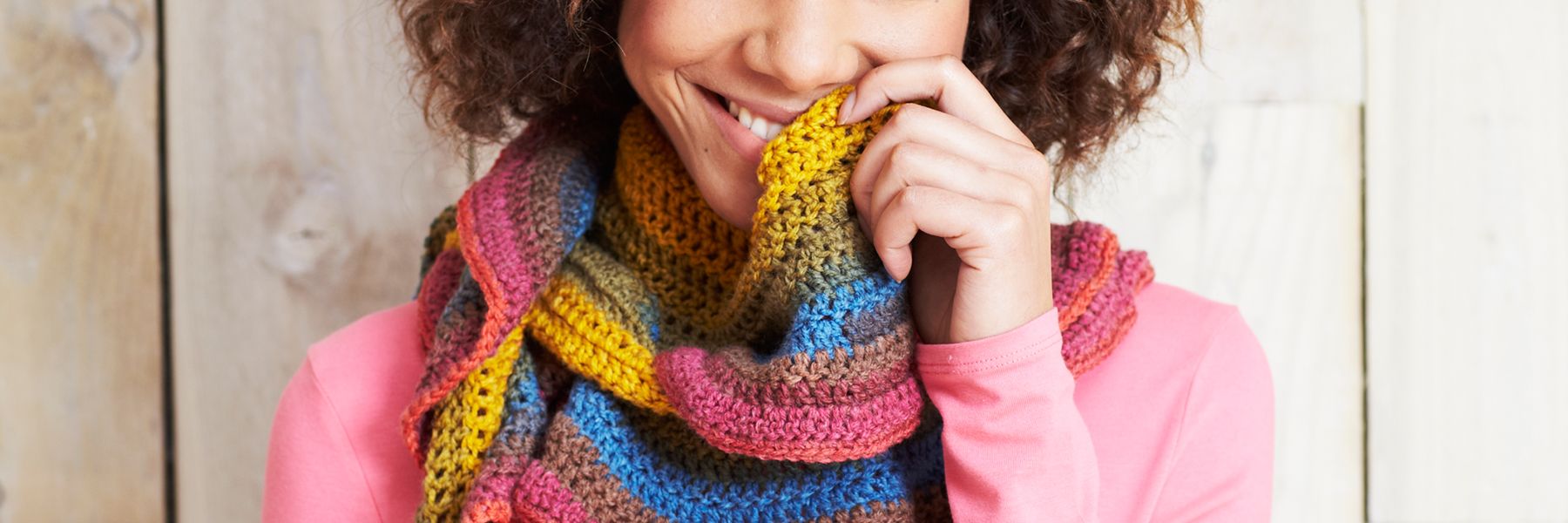Buying Guides

Knitting buying guide
Our guide will help you pick the best needles and wool for your next project, especially if you’re new to the craft. Look out for knitting workshops in our Haberdashery departments in store too.
wool
The right wool or yarn for your project depends on:
The pattern you’ve chosen
The needles you have
The effect you want to create
Labels usually tell you the fibre content, weight and care instructions. You may also find the recommended tension and needle size included.
Colour information will also include a dye lot number. Wool is dyed in batches and each one can vary slightly, so it’s a good idea to buy all the wool you’ll need for your project at once, to make sure the colour is consistent.
Yarn comes packaged in three different ways:
A ball, where the wool is wound into a ball with the end on the outside
A skein is similar, but wound up into an oblong shape and you pull the end from the inside instead
A hank is a loose twist, which you need to wind into a ball before knitting

Ply
This is the thickness of the wool. Yarn can be made up of a single strand of fibre, or a number of strands twisted together. Thicker yarns are made of more tightly spun strands.
From lightest to heaviest weight, wool is classed as:
- Baby: designed for babies, this fabric is less fluffy, which helps stop the fibres going into a baby’s mouth. It’s generally lightweight, delicate and soft
- 2/3 Ply: refers to the number of strands twisted together. It should be used for projects like gloves or socks, where accuracy is important for fit
- 4 Ply: also known as sport, this type is suitable for baby clothes or lacy garments
- Double Knitting (DK): the most versatile and widely used yarn, it’s called DK as it’s double the weight of 4 Ply yarn. It’s sometimes referred to as Light Worsted and is suitable for all kinds of garments
- Aran: named after traditional knitting from the Aran Isles and also known as Fisherman, this type is ideal for chunky jumpers
- Chunky: chunkier styles create quicker, thicker knits, so they’re a good choice for beginners. Sometimes known as Bulky, they make cosy jumpers and outerwear
- Super Chunky: a great ‘quick-knit’ yarn and a good choice for beginners, it’s also known as Super Bulky
- Fashion: these more unusual yarns are perfect for projects like statement scarves
Materials
For clothing and accessories, choose fibres that are non-scratchy and soft against the skin. Look for sturdy, durable fibres for rugs and home accessories.
The blend mix will show you the exact percentages of different materials within yarn. When shopping for wool, filter your choices by clicking on specific blend types. This will quickly narrow down the right wool for you.
- Animal fibres: Wool, alpaca, silk and mohair are popular, traditional choices for knitters as they’re warm and cosy. Silk, alpaca and mohair have a beautiful handle and a luxurious feel. Mohair and angora have a fluffy feel; to work with them, you might require larger needles
- Plant-based fibres: Cotton, bamboo and hemp are practical and versatile fibres that are hard-wearing and breathable
- Synthetic fibres: Easy-care fibres like acrylic, nylon, polyester and viscose are usually machine washable and good value. Acrylic is a practical choice for baby garments that need regular washing
- Speciality yarns: Chenille produces a velvet-like texture; bouclé yarns work for textured knits; metallic yarns make an ideal choice for evening wear; ribbon yarn has a flat strip shape that’s great for spring and summer garments
Needles
Types
If you’ve already bought your wool, you’ll find the recommended needle size on the packaging. Matching the wool and needles ensures you create the right tension in your knitting, so it’s not too loose or too tight and the finished project turns out at the planned size.
- Straight needles are the most common type, used in pairs. They’re suited to flat knitting.
- Double-pointed needles have points that allow you to knit from either end. They’re generally sold in packs of four or five; by using more than two together you can create circular knitting for socks and sleeves.
- Circular needles are two needles tapered at one end and joined at the end by a flexible cord. Used to create fabric without seams, these needles create a continuous spiral and the longer the tube that connects the needles, the wider the knit.
Sizes
Length: Longer needles have room for more stitches, producing a wider knit. If you’re a beginner working on a small project, you might find shorter needles more manageable.
Diameter: The diameter of your needles determines the size of the stitches you’ll create. Generally, the wider the needle, the thicker the yarn needed, though you can use a wider needle with a thinner ply yarn to knit an open, loose fabric.
Needle size conversion table:
| Metric Sizes (mm) |
UK sizes |
US sizes |
| 2mm | 14 | 0 |
| 2.25mm | 13 | 1 |
| 2.75mm | 12 | 2 |
| 3mm | 11 | - |
| 3.25mm | 10 | 3 |
| 3.5mm | - | 4 |
| 3.75mm | 9 | 5 |
| 4mm | 8 | 6 |
| 4.5mm | 7 | 7 |
| 5mm | 6 | 8 |
| 5.5mm | 5 | 9 |
| 6mm | 4 | 10 |
| 6.5mm | 3 | 10.5 |
| 7mm | 2 | - |
| 7.5mm | 1 | - |
| 8mm | 0 | 11 |
| 9mm | 00 | 13 |
| 10mm | 000 | 15 |
| 12.5mm | - | 17 |
| 15mm | - | 19 |
| 19mm | - | 35 |
| 20mm | - | 36 |
| 25mm | - | 50 |
Needle material
- Metal is generally more hard-wearing than bamboo or wood
- Bamboo or wooden needles are quieter than metal and warmer to hold
Tip
Some needles have a square cross section; these are a good choice for beginners or those with arthritis as they’re easy to grip
Technique
Tension
Tension (also known as gauge) refers to the number of stitches (width) and number of rows (height) you’ll need to create in order to knit a 10cm square.
Working out the tension is particularly important when it comes to making clothes, as it allows you to work out the number of stitches and rows you’ll need to create the finished item. By working out the stitches and rows in a 10cm square, you can calculate the stitches and rows you’ll need to create the final measurements of your entire garment by multiplying.
Tension is included on the wool label, though be aware that the combination of the wool, your needles and your personal knitting style will lead to variations. Knit a 10cm square and look at the corresponding guidelines to see how your combination compares.
| Ply | Tension | Needle Size |
| 2 Ply | 27-32 sts |
2.24-3.25mm |
| 4 Ply |
23-26 sts |
3.25-3.75 |
| DK |
21-24 sts |
3.75-4.5mm |
| Aran |
16-20 sts |
4.5-5.5mm |
| Chunky |
12-15 sts |
5.5-8mm |
| Super Chunky |
16-11 sts |
8mm+ |
Accessories
Stitch counters slip onto one needle and allow you to count how many rows you’ve knitted
- Stitch markers are used to mark out your knitting and are useful for keeping track of different stitches
- Cable needles are smaller needles for creating cables by holding stitches apart as you knit
- Point protectors safeguard the end of your needles from wear and tear if you carry your knitting around with you often
- Stitch holders resemble large safety pins and hold a section of stitching while you knit the rest, so it doesn’t unravel
- Crochet hooks are available in a variety of sizes and materials, useful for picking up dropped stitches
- Pins temporarily hold knitted pieces while you sew them together
- Tape measures can be used to check the tension and measure your finished knitting
- Needle gauge measures the size of your needles as not all needles are marked
- Darning needles are for sewing in all the yarn ends and for sewing up seams. Once you’ve completed your knitted piece, you can weave the loose piece of wool back through the stitches for a neat finish
- Bobbins hold a length of yarn while working on intarsia (patterned stitches)
- Graph paper can be used to plot out a pattern or work out intarsia colours – just count each square as a stitch

Hints & Tips
- Uneven tension
Too tight: may be caused by creating stitches on the tip of the needles. Choose needles with a shorter point
Too loose: you may need to pull your yarn tighter as you knit the stitches - Dropped stitches
There’s no need to unpick the rows and start again; use a crochet hook in a similar size to the knitting needles to pick up the stitches - Keeping track of your knitting
With more complex designs, it’s easy to lose track of where you are in your pattern. Use marker pins to map out your design. Avoid knitting a really intricate pattern with a fashion yarn as the design will be lost. - Variance in yarn dye
There are usually variances in the dyeing process, which can affect the colour result. Do check how much yarn you need before starting a project, so that you can check the labels all carry the same dye lot or batch number to guarantee a colour match. If you need extra yarn at a later date, there may be shade variances between batches. And it’s always a good idea to add on at least one more ball to cover any unforeseen mishaps.
Patterns
All patterns use abbreviations to describe the types of stitches you’ll need to knit.
| Stitch |
Abbreviation |
| alt |
alternate |
| beg |
beginning |
| cm |
centimetres |
| CO |
cast on |
| cont. |
continue |
| dec |
decrease by working two stitches together |
| g |
grams |
| inc |
increase by knitting into the front and back of the same stitch |
| in |
inches |
| K |
knit |
| K2tog |
knit two stitches together |
| LH |
left hand |
| no. |
number |
| P |
purl |
| P2tog |
purl two stitches together |
| rem |
remaining |
| rep |
repeat |
| RH |
right hand |
| rs |
right side |
| St st |
stockinette stitch |
| st |
stitch |
| sts |
stitches |
| tog |
together |
| ws |
wrong side (the inside of the piece: the part that won't be seen) |
| yo |
yarn over |
| * | marks the beginning of pattern repeats |
Some patterns will include square, gridded charts with symbols to describe stitches.
They’re helpful if you make a mistake and need to backtrack, as the simple layout offers easy-to-follow instructions.
